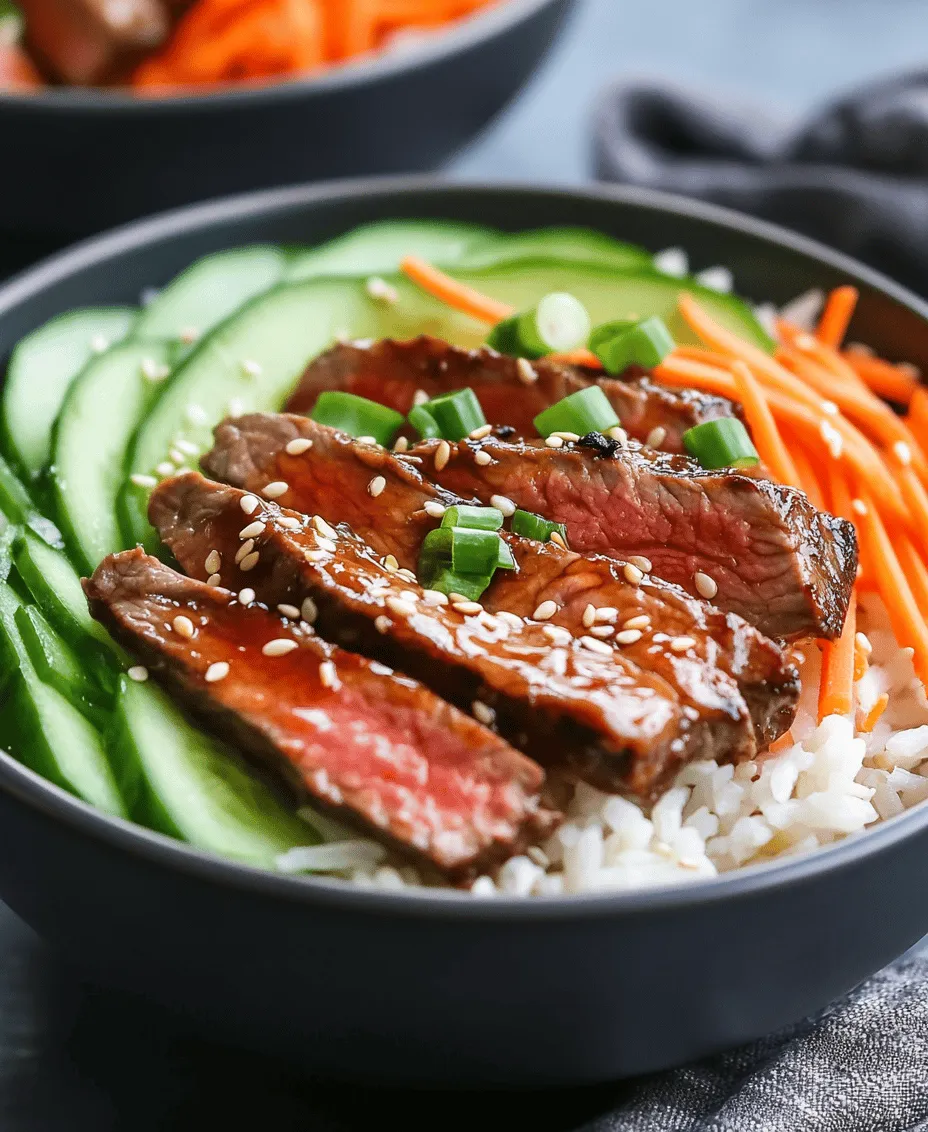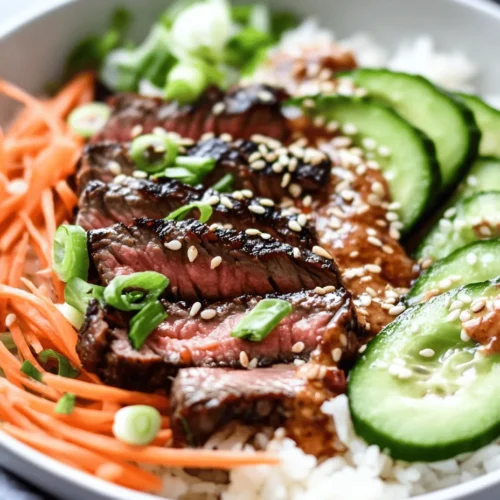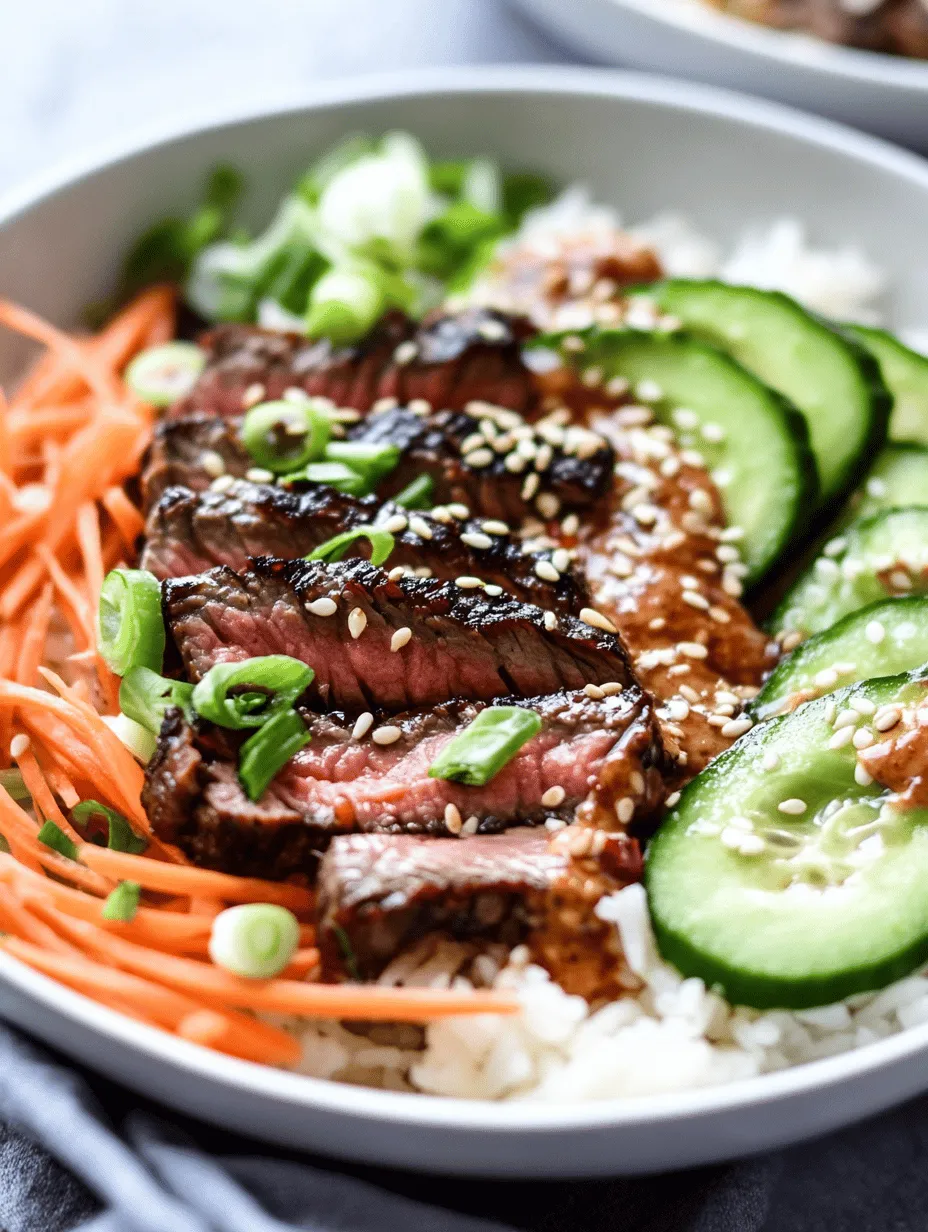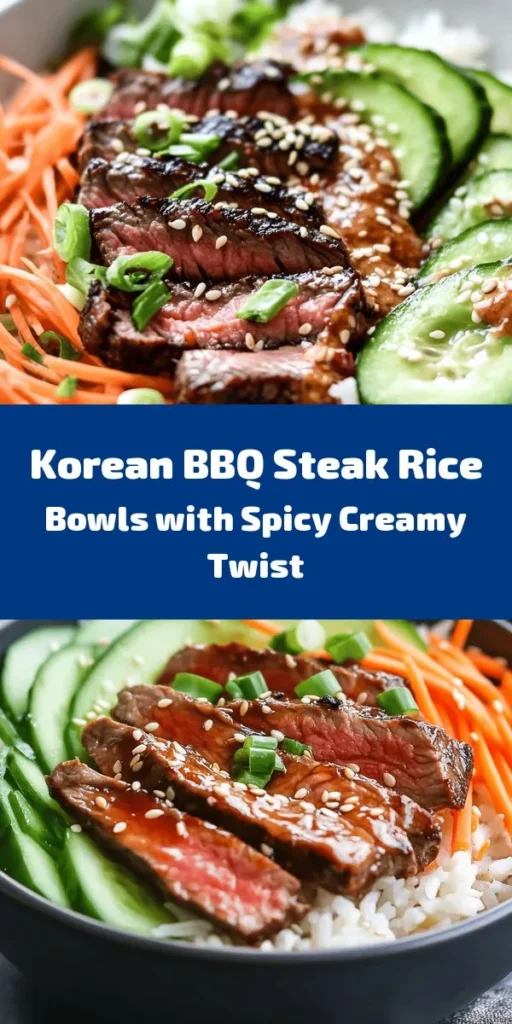Introduction
Korean cuisine has surged in popularity over the last decade, captivating food enthusiasts with its vibrant flavors and rich culinary traditions. Among the many beloved dishes, Korean BBQ stands out for its unique grilling techniques and delectable marinated meats. The sizzling sound of beef on a hot grill, coupled with an array of mouthwatering side dishes, makes for an unforgettable dining experience. One dish that perfectly encapsulates these flavors is the Korean BBQ Steak Rice Bowl with Spicy Cream Sauce. This dish not only showcases the savory essence of Korean BBQ but also emphasizes the importance of balanced meals, featuring protein, fresh vegetables, and grains.
Korean BBQ Steak Rice Bowls are incredibly versatile, allowing for customization based on personal preferences and dietary needs. Whether you’re hosting a gathering, preparing a quick weeknight dinner, or seeking a meal prep option, these rice bowls can be tailored to suit any occasion. The combination of tender marinated steak, crisp vegetables, and creamy sauce creates a delightful contrast in textures and flavors that will please both seasoned foodies and those new to Korean cuisine.
In this article, we will delve into the essential ingredients and cooking techniques that make Korean BBQ Steak Rice Bowls a must-try dish for anyone looking to elevate their home cooking game.
Understanding the Key Ingredients
Flank Steak: The Star of the Dish
Flank steak is the preferred cut for this recipe due to its rich flavor and ideal texture for grilling. This cut comes from the abdominal muscles of the cow and is known for its lean quality and fibrous structure. When cooked correctly, flank steak can be incredibly tender and juicy. Its ability to absorb marinades makes it a favorite in many Asian cuisines, particularly in Korean BBQ.
Choosing the right flank steak is crucial for achieving the best results. Look for a cut that has a bright red color with minimal marbling. This will ensure that you’re working with high-quality meat that will deliver on flavor and tenderness. For those who may prefer alternatives, skirt steak or sirloin can also be suitable options, though they each bring their own unique characteristics to the dish.
The Role of Soy Sauce in Korean Cooking
Soy sauce is a cornerstone of Korean cooking, recognized for its ability to enhance flavors and provide umami depth to dishes. This fermented condiment adds a savory richness that complements the natural taste of meats while providing a beautiful brown color during cooking. In this recipe, soy sauce plays a significant role in the marinade, ensuring that the flank steak absorbs a delightful mixture of flavors.
There are various types of soy sauce available, such as light, dark, and sweet soy sauce, each with its own flavor profile. For this recipe, a good-quality, naturally brewed soy sauce is recommended, as it provides a well-rounded flavor without overpowering the other ingredients.
Sesame Oil: A Distinct Flavor Profile
Another key ingredient in Korean BBQ is sesame oil, which adds a nutty aroma and depth of flavor to dishes. Unlike regular cooking oils, sesame oil is typically used as a finishing oil or in dressings due to its strong flavor, which can easily dominate a dish if used in excess. Incorporating a small amount of sesame oil into the marinade not only enhances the taste of the steak but also adds a layer of authenticity to the dish.
When selecting sesame oil, opt for toasted sesame oil, which is richer and has a more robust flavor compared to regular sesame oil. This will elevate the overall profile of your Korean BBQ Steak Rice Bowls, making them even more delicious.
Fresh Vegetables: A Nutritional Boost
To create a well-rounded meal, it’s essential to include fresh vegetables that not only add flavor but also contribute important nutrients. For this recipe, we will be using cucumbers, carrots, and avocados.
Cucumbers provide a refreshing crunch that balances the richness of the marinated steak. They can be sliced thinly or julienned for added texture. Carrots bring a natural sweetness and vibrant color, which enhances the visual appeal of the dish. Finally, avocado adds creaminess and healthy fats, making the rice bowls more filling and satisfying.
Jasmine Rice: A Staple in Asian Dishes
No rice bowl is complete without a base of perfectly cooked rice, and jasmine rice is a popular choice in many Asian cuisines. Known for its fragrant aroma and slightly sticky texture, jasmine rice complements the flavors of the Korean BBQ beautifully. When cooked properly, it provides a fluffy and tender base that allows the other ingredients to shine.
Cooking jasmine rice requires a specific technique to ensure that it reaches the perfect texture. It’s important to rinse the rice thoroughly before cooking to remove excess starch, which can make the rice gummy. With the right cooking method, jasmine rice can be a delightful addition to any meal.
The Marination Process
Importance of Marinating Steak
Marinating the flank steak is a crucial step in this recipe, as it not only infuses the meat with flavor but also helps to tenderize it. The combination of soy sauce, sesame oil, brown sugar, garlic, and ginger creates a delicious marinade that permeates the meat, transforming it into a flavorful centerpiece for your rice bowl.
When marinating, it’s essential to allow enough time for the flavors to penetrate the meat fully. A longer marination time can lead to a more intense flavor, while a shorter time can still yield delicious results. The key is to find the right balance that works for your schedule.
Detailed Breakdown of the Marinade Ingredients
1. Soy Sauce: Provides savory depth and umami flavor.
2. Brown Sugar: Adds a touch of sweetness, balancing the savory elements of the marinade.
3. Sesame Oil: Contributes a nutty flavor that enhances the overall taste.
4. Garlic: Offers aromatic richness and a hint of spiciness.
5. Ginger: Adds a fresh, zesty note that brightens the marinade.
To create the marinade, simply mix these ingredients in a bowl until well combined. For optimal flavor absorption, place the flank steak in a resealable plastic bag or a shallow dish, and pour the marinade over the meat. Ensure that the steak is evenly coated, then seal the bag or cover the dish with plastic wrap.
Suggested Marination Times and Techniques
For the best results, marinate your flank steak for at least 30 minutes, but if time allows, aim for 2 to 4 hours. Some enthusiasts even recommend marinating overnight for maximum flavor. However, be cautious not to exceed 24 hours, as the acid in the soy sauce can begin to break down the meat too much, resulting in an undesirable texture.
When you’re ready to grill, remove the steak from the marinade and let it come to room temperature for about 15 minutes. This step helps the steak cook more evenly, ensuring that you achieve the perfect doneness.
Tips for Choosing Flank Steak and Alternatives
When selecting flank steak, look for cuts that are bright red with a smooth surface. Avoid any pieces that appear discolored or have an off smell. If you’re unable to find flank steak, consider using skirt steak, which has a similar flavor but may be slightly fattier. For those looking for a leaner option, sirloin or even chicken breast can be great alternatives, though they will require different marination times and cooking techniques.
In the next section, we will cover the essential steps for cooking perfect jasmine rice, ensuring a fluffy and delicious base for your Korean BBQ Steak Rice Bowls.
Cooking the Perfect Jasmine Rice
Rinsing and Cooking Jasmine Rice
To achieve the best texture for jasmine rice, start by rinsing it under cold water. Place the rice in a fine-mesh strainer or bowl, and run cool water over it, gently swishing the rice with your hands. Rinse the rice until the water runs clear, which indicates that excess starch has been removed. This step is crucial for preventing gummy rice.
Once rinsed, transfer the rice to a pot and add water. The typical ratio for cooking jasmine rice is 1 cup of rice to 1.5 cups of water. However, this can vary slightly based on personal preference and the specific brand of rice. For a slightly firmer texture, reduce the water to 1.25 cups.
Tips for Achieving Perfect Texture and Fluffiness
Bring the water to a boil over medium-high heat, then reduce the heat to low, cover the pot with a lid, and allow the rice to simmer. It’s vital not to lift the lid during cooking, as this can disrupt the steaming process. Allow the rice to cook for about 15 minutes or until all the water is absorbed.
Once the cooking time is complete, remove the pot from the heat and let it sit, covered, for an additional 10 minutes. This resting period allows the rice to finish cooking and ensures a fluffy texture. Afterward, use a fork to fluff the rice gently before serving.
Importance of Letting the Rice Sit Post-Cooking
Letting the rice sit after cooking is a crucial step that many home cooks overlook. This resting time allows the steam to redistribute throughout the rice, resulting in a more even texture and preventing clumping. The outcome is perfectly cooked jasmine rice that serves as a delightful base for your Korean BBQ Steak Rice Bowls.
In the following sections, we will explore the best practices for grilling the flank steak, ensuring that you achieve the ideal doneness while preserving its juicy flavor. Prepare to impress your friends and family with this restaurant-quality dish that you can effortlessly recreate at home.

Tips for Slicing Steak Against the Grain for Tenderness
One of the most critical steps in preparing your Korean BBQ steak rice bowls is slicing the steak correctly. Slicing against the grain ensures that each bite is tender and easy to chew. The first step is to identify the direction of the grain, which refers to the way the muscle fibers run in the meat. To slice against the grain, follow these tips:
1. Observe the Grain: After cooking your steak to your desired doneness, let it rest for about 5-10 minutes. This resting period allows the juices to redistribute throughout the meat. Once rested, take a closer look at the steak and note the direction of the muscle fibers.
2. Use a Sharp Knife: A sharp knife is essential for clean cuts. Dull knives can tear the meat fibers, resulting in a less appealing texture. A chef’s knife or a carving knife works best for this.
3. Cut Thinly: Aim for slices that are about 1/4 inch thick. Thinner slices will be more tender and easier to incorporate into your rice bowl.
4. Angle Your Cuts: Instead of cutting straight down, slightly angle your knife as you slice. This technique increases the surface area of each piece, enhancing both tenderness and flavor absorption.
5. Practice Makes Perfect: If you’re new to slicing meat, practice on less expensive cuts of meat to build your confidence.
Suggestions for Grilling Methods: Skillet vs. Outdoor Grill
When it comes to cooking your steak, you have options—each with its unique advantages:
– Skillet Cooking: Using a cast-iron skillet allows for excellent heat retention and even cooking. Preheat your skillet over medium-high heat, add a bit of oil with a high smoke point, such as canola or avocado oil, and sear the steak for about 3-4 minutes on each side. This method is ideal for those who may not have access to an outdoor grill and can produce a delicious crust on your steak.
– Outdoor Grilling: If you have access to a grill, this method imparts a wonderful smoky flavor. Preheat the grill and ensure the grates are clean and oiled. Grill your steak for roughly the same time as the skillet method, depending on the thickness of your cut. The grill marks add visual appeal and enhance the dish’s overall presentation.
Both methods yield fantastic results, so choose the one that fits your cooking environment and preferences!
Crafting the Spicy Cream Sauce
Now, let’s dive into the spicy cream sauce that elevates these rice bowls. This sauce combines heat, creaminess, and a hint of sweetness for a well-rounded flavor profile.
Breakdown of the Sauce Ingredients
For the spicy cream sauce, you’ll need the following ingredients:
– Sriracha: This chili sauce provides the heat. Its tangy flavor contributes depth, making it a staple in Korean cuisine.
– Heavy Cream: For a rich and creamy texture, heavy cream is essential. It balances the spiciness of the sriracha and gives the sauce a luxurious mouthfeel.
– Lime Juice: Fresh lime juice adds acidity, brightening the overall flavor and cutting through the richness of the cream.
– Honey: A touch of honey balances the spice and acidity, creating a harmonious blend of flavors.
Importance of Balancing Heat
Balancing the heat is crucial for creating a sauce that appeals to a variety of palates. Start with a small amount of sriracha, increasing it gradually until you reach your desired spice level. The lime juice and honey help temper the heat, allowing the flavors to shine without overwhelming the dish.
Tips for Adjusting the Spice Level
– For Mild Heat: Start with a teaspoon of sriracha and taste before adding more.
– For Extra Heat: Consider adding red pepper flakes or a dash of gochujang (Korean chili paste) for an additional layer of flavor.
– For Sweetness: Add more honey if you prefer a sweeter sauce, which can be particularly appealing if you’re serving children or those sensitive to spice.
Creative Variations of the Sauce
Feel free to experiment with the sauce to complement different dishes. Here are some variations:
– Herbed Cream Sauce: Add fresh herbs like cilantro or green onions for a fresh twist.
– Miso Cream Sauce: Mix in a tablespoon of miso paste for an umami boost.
– Sesame Ginger Sauce: Incorporate sesame oil and grated ginger for an Asian flair that pairs beautifully with grilled meats.
Assembling the Rice Bowls
Once your steak is cooked and the sauce is ready, it’s time to assemble your rice bowls for an appealing presentation.
Step-by-Step Guide to Plating the Rice Bowls
1. Start with Rice: Begin by placing a generous scoop of cooked rice at the bottom of each bowl. Short-grain rice or jasmine rice works well for this dish.
2. Layer the Ingredients: Next, arrange the sliced steak on top of the rice. Ensure that the pieces are evenly distributed for a balanced bite.
3. Add Vegetables: Include a variety of colorful vegetables such as sliced cucumbers, shredded carrots, and bell peppers. This not only adds flavor but also enhances the visual appeal.
4. Drizzle the Sauce: Generously drizzle the spicy cream sauce over the steak and vegetables.
5. Garnish: Finish off with toppings like sesame seeds, sliced scallions, or fresh herbs for the perfect finishing touch.
Importance of Layering Ingredients
Layering ingredients thoughtfully enhances both flavor and texture. Each bite should offer a combination of the creamy sauce, tender steak, and fresh vegetables, creating a satisfying culinary experience.
Suggestions for Additional Toppings or Variations
– Pickled Vegetables: Add some tangy pickled radishes or kimchi for a traditional Korean touch.
– Soft-Boiled Egg: A soft-boiled egg on top adds richness and a beautiful presentation.
– Nuts and Seeds: Chopped peanuts or sesame seeds can provide a delightful crunch.
Importance of Presentation
The way you present the rice bowls can significantly enhance the dining experience. A well-arranged bowl is not only more appetizing but also reflects the care and attention you’ve put into the dish. Use vibrant colors and varied textures to create an enticing meal.
Serving Suggestions
Korean BBQ Steak Rice Bowls are versatile and perfect for several occasions.
Ideal Occasions for Serving
– Family Dinners: These rice bowls are a great way to bring everyone together for a comforting meal.
– Meal Prep: Prepare the components in advance and assemble them quickly during the week for easy lunches or dinners.
– Gatherings: Impress your guests with this flavorful dish at gatherings or dinner parties.
Suggestions for Side Dishes
To round out your meal, consider serving side dishes that complement the flavors of the rice bowls:
– Pickled Vegetables: The crunchy, tangy taste of pickled vegetables pairs beautifully with the richness of the steak and sauce.
– Kimchi: A staple in Korean cuisine, kimchi adds a spicy, fermented flavor that enhances the overall meal.
Pairing Ideas
When it comes to beverages, consider these pairings to elevate your dining experience:
– Korean Soju: This traditional Korean spirit is a classic pairing with BBQ dishes.
– Light Beer: A crisp lager or pilsner can balance the richness of the steak.
– Iced Green Tea: For a non-alcoholic option, iced green tea provides a refreshing contrast.
Nutritional Breakdown
Understanding the nutritional benefits of your dish can help you feel good about what you’re eating.
Analysis of Nutritional Benefits
– Protein: The steak provides a significant amount of protein, essential for muscle repair and overall health.
– Healthy Fats: The cream and any oil used in cooking provide healthy fats, which are vital for nutrient absorption.
– Vitamins from Vegetables: The addition of fresh vegetables supplies essential vitamins and minerals, contributing to a balanced meal.
Discussion on Portion Control
Portion control is key to maintaining a balanced diet. While this dish is filling and nutritious, be mindful of your serving size to avoid overeating, especially if you’re pairing it with sides.
Potential Dietary Modifications
This recipe is versatile and can be modified to meet various dietary preferences:
– Gluten-Free: Use gluten-free soy sauce or tamari for the steak marinade.
– Vegetarian Alternatives: Substitute the steak with grilled tofu or a hearty mushroom for a delicious plant-based option.
– Dairy-Free: Replace heavy cream with coconut milk for a dairy-free version of the spicy cream sauce.
Conclusion
Korean BBQ Steak Rice Bowls with Spicy Cream Sauce are a delightful fusion of flavors and textures that excite the palate. This dish not only offers a satisfying meal but also brings comfort and joy through the vibrant tastes of Korean cuisine. Whether you’re cooking for family, meal prepping, or entertaining guests, these rice bowls are sure to impress.
Exploring the diverse flavors of Korean cuisine in your own kitchen can be a rewarding experience. So gather your ingredients, embrace the cooking process, and enjoy the delightful results of your culinary efforts. With each bite, you’ll discover the essence of Korean flavors and the joys of home cooking.



